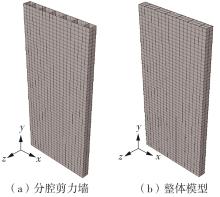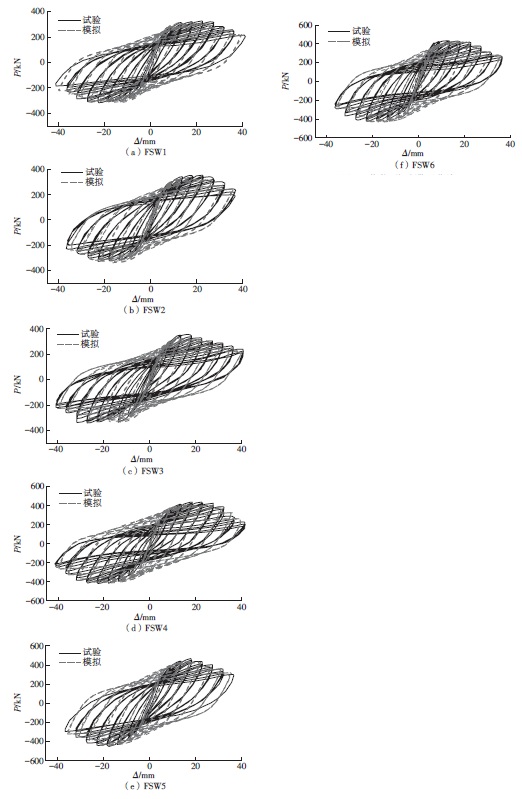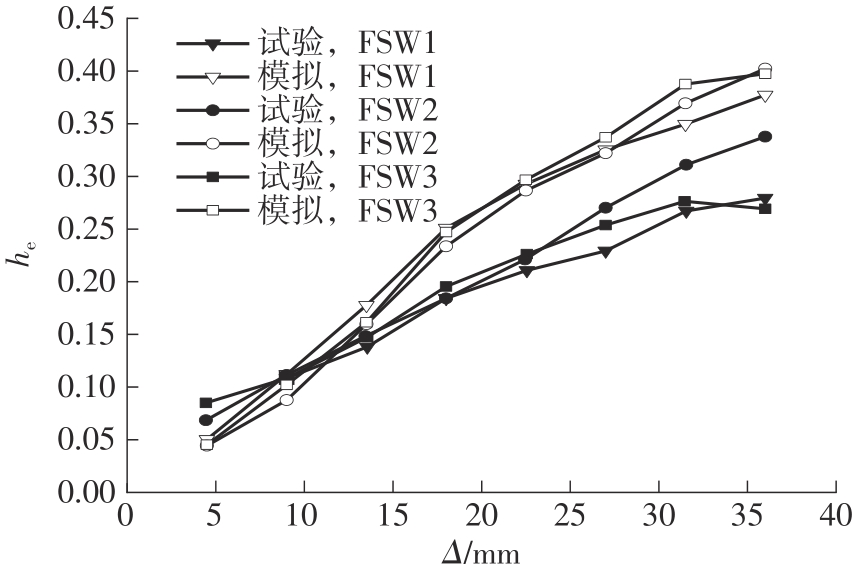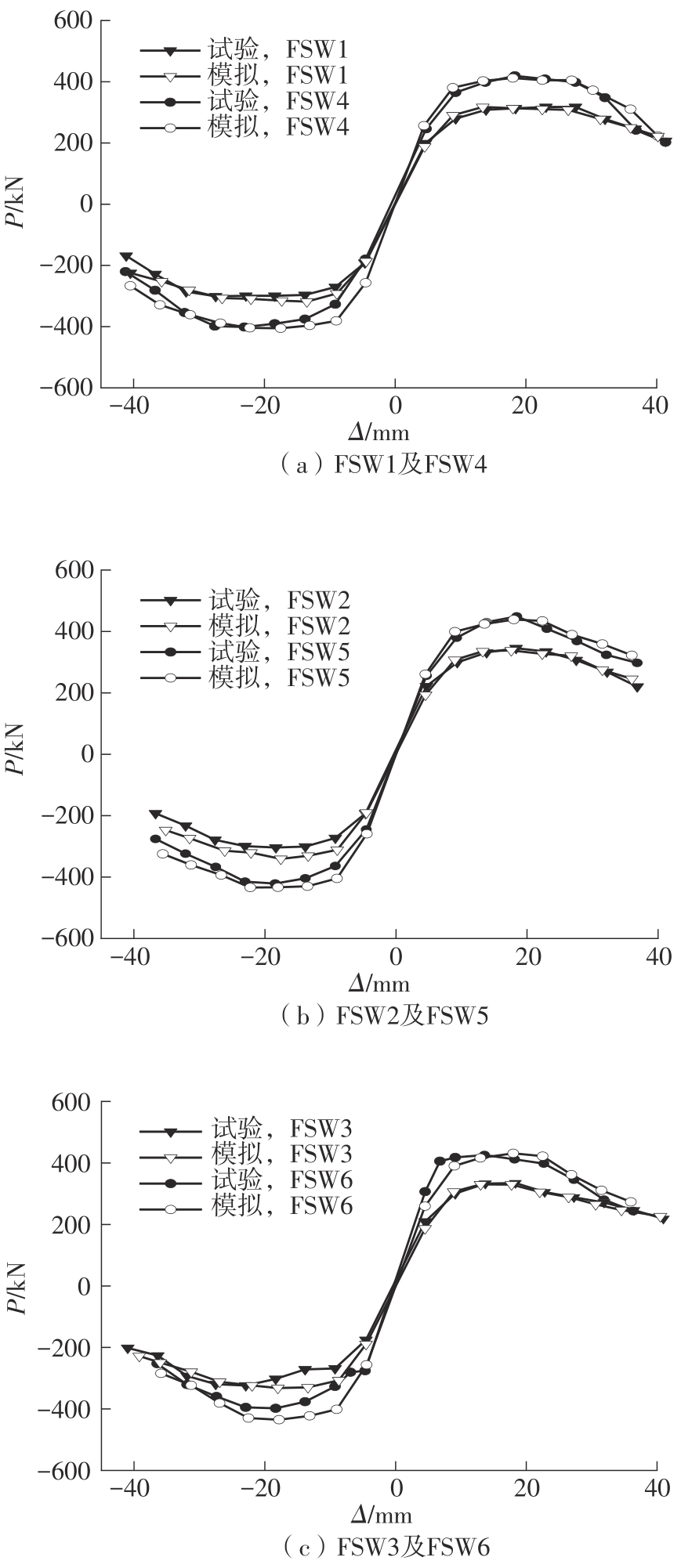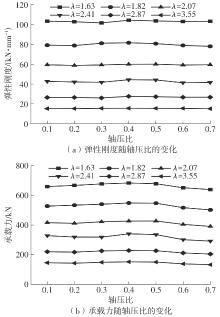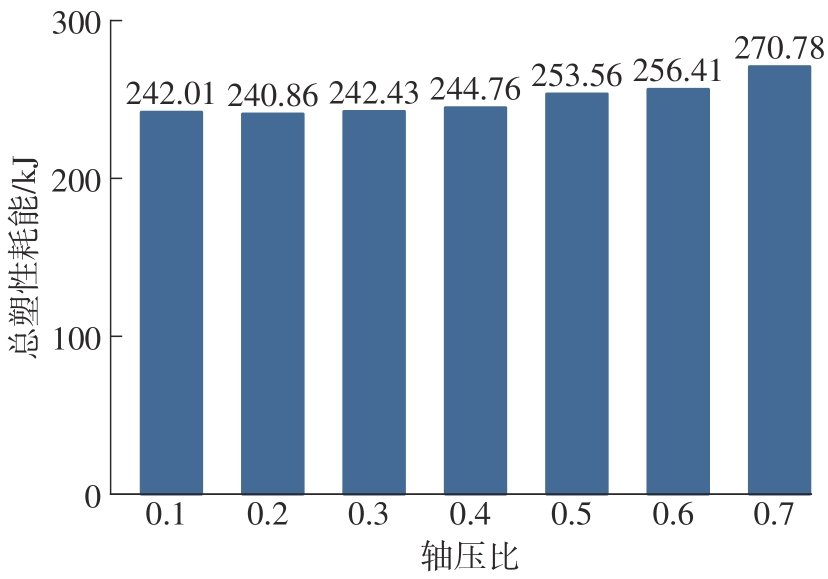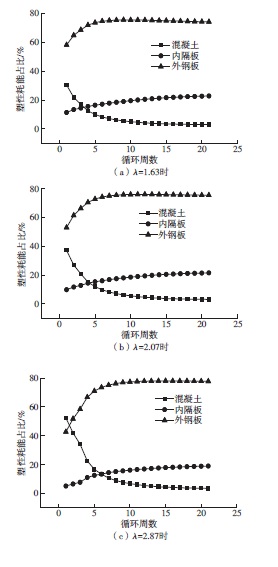华南理工大学学报(自然科学版) ›› 2024, Vol. 52 ›› Issue (1): 15-25.doi: 10.12141/j.issn.1000-565X.220828
焊接多腔双钢板-混凝土组合剪力墙抗震性能分析
丁发兴1 蔡勇强1 王莉萍1 孙浩1 吕飞1 黄修文2
- 1.中南大学 土木工程学院,湖南 长沙 410075
2.中铁三局集团有限公司,山西 太原 030000
-
收稿日期:2022-12-26出版日期:2024-01-25发布日期:2023-06-19 -
作者简介:丁发兴(1979-),男,教授,博士生导师,主要从事钢-混凝土组合结构研究。E-mail:dinfaxin@csu.edu.cn -
基金资助:国家自然科学基金资助项目(51978664)
Seismic Performance Analysis of Welded Multi-Cavity Double Steel Plate-Concrete Composite Shear Wall
DING Faxing1 CAI Yongqiang1 WANG Liping1 SUN Hao1 LÜ Fei1 HUANG Xiuwen2
- 1.School of Civil Engineering,Central South University,Changsha 410075,Hunan,China
2.China Railway Third Bureau Group Co. ,Ltd. ,Taiyuan 030000,Shanxi,China
-
Received:2022-12-26Online:2024-01-25Published:2023-06-19 -
About author:丁发兴(1979-),男,教授,博士生导师,主要从事钢-混凝土组合结构研究。E-mail:dinfaxin@csu.edu.cn -
Supported by:the National Natural Science Foundation of China(51978664)
摘要:
大多数双钢板-混凝土组合剪力墙采用螺栓连接或焊接肋的方式使钢板和混凝土协同工作。然而,这种连接方式可能导致整体性和塑性变形效率较低,且制作复杂,焊接多腔双钢板-混凝土组合剪力墙能够有效地避免这些问题。为了深入研究焊接多腔双钢板-混凝土组合剪力墙的抗震性能,基于约束混凝土真三轴塑性-损伤本构模型和钢材弹塑性混合强化-韧性损伤本构模型,建立了组合剪力墙的精细化三维实体-壳模型,将模拟所得的滞回曲线、骨架曲线、刚度退化曲线、弹性刚度、承载力、累积耗能、等效阻尼粘滞系数和延性系数与已有拟静力试验结果相比较,发现两者吻合较好。分析结果表明:轴压比对组合剪力墙模型算例刚度和承载力的影响较小,而随剪跨比增大,组合剪力墙模型算例的刚度和承载力呈线性降低;轴压比对组合剪力墙模型算例总塑性耗能的影响较小,而剪跨比的影响较大,剪力墙总塑性耗能随剪跨比增大而降低;轴压比和剪跨比都不会改变算例各部件的耗能分配机制,即组合剪力墙模型算例以外钢板和内隔板耗能为主。
中图分类号:
引用本文
丁发兴, 蔡勇强, 王莉萍, 等. 焊接多腔双钢板-混凝土组合剪力墙抗震性能分析[J]. 华南理工大学学报(自然科学版), 2024, 52(1): 15-25.
DING Faxing, CAI Yongqiang, WANG Liping, et al.. Seismic Performance Analysis of Welded Multi-Cavity Double Steel Plate-Concrete Composite Shear Wall[J]. Journal of South China University of Technology(Natural Science Edition), 2024, 52(1): 15-25.
表2
延性系数模拟结果与试验结果的比较"
| 试件 | 加载方向 | 试验结果 | 有限元模拟结果 | ||||
|---|---|---|---|---|---|---|---|
| Δy/mm | Δu/mm | μ | Δy/mm | Δu/mm | μ | ||
| FSW1 | + | 7.51 | 31.19 | 4.12 | 8.33 | 33.69 | 4.04 |
| - | 7.61 | 33.55 | 4.41 | 8.29 | 33.74 | 4.07 | |
| FSW2 | + | 7.20 | 29.25 | 4.06 | 7.86 | 30.77 | 3.92 |
| - | 7.41 | 29.67 | 4.00 | 7.83 | 30.89 | 3.94 | |
| FSW3 | + | 7.27 | 28.42 | 3.91 | 7.88 | 31.12 | 3.95 |
| - | 8.49 | 33.13 | 3.90 | 7.93 | 30.84 | 3.89 | |
| FSW4 | + | 7.95 | 31.16 | 3.92 | 8.45 | 32.28 | 3.82 |
| - | 10.32 | 33.07 | 3.21 | 8.51 | 32.75 | 3.85 | |
| FSW5 | + | 8.17 | 26.09 | 3.19 | 7.95 | 31.41 | 3.95 |
| - | 7.88 | 28.40 | 3.60 | 8.02 | 31.09 | 3.88 | |
| FSW6 | + | 6.38 | 25.70 | 4.03 | 7.78 | 30.34 | 3.90 |
| - | 6.67 | 26.45 | 3.97 | 7.84 | 30.75 | 3.92 | |
表6
组合剪力墙模型算例总塑性耗能和各部件塑性耗能占比随轴压比的变化1)"
| 剪跨比 | 轴压比 | 总塑性耗能/kJ | 核心混凝土塑性耗能/kJ | 内隔板塑性耗能/kJ | 外钢板塑性耗能/kJ |
|---|---|---|---|---|---|
| 2.41 | 0.1 | 242.01(100.0%) | 7.11(3.0%) | 47.52(19.6%) | 187.38(77.4%) |
| 2.41 | 0.2 | 240.86(99.5%) | 7.26(3.0%) | 48.25(20.0%) | 185.36(77.0%) |
| 2.41 | 0.3 | 242.43(100.2%) | 8.01(3.3%) | 49.85(20.6%) | 184.57(76.1%) |
| 2.41 | 0.4 | 244.76(101.1%) | 9.06(3.7%) | 51.91(21.2%) | 183.80(75.1%) |
| 2.41 | 0.5 | 253.56(104.8%) | 10.33(4.1%) | 55.33(21.8%) | 187.90(74.1%) |
| 2.41 | 0.6 | 256.41(106.0%) | 13.22(5.2%) | 57.29(22.3%) | 185.90(72.5%) |
| 2.41 | 0.7 | 270.78(111.9%) | 17.08(6.3%) | 61.00(22.5%) | 192.70(71.2%) |
表4
组合剪力墙模型算例弹性刚度随剪跨比的变化"
| 剪跨比 | 不同轴压比下的弹性刚度/(kN·mm-1) | ||||||
|---|---|---|---|---|---|---|---|
| 0.1 | 0.2 | 0.3 | 0.4 | 0.5 | 0.6 | 0.7 | |
| 1.63 | 103.26 | 102.70 | 101.53 | 104.26 | 103.52 | 102.95 | 103.21 |
| 1.82 | 79.11 | 78.74 | 81.04 | 81.58 | 80.66 | 78.87 | 77.97 |
| 2.07 | 59.35 | 58.66 | 59.22 | 59.85 | 59.94 | 59.10 | 59.41 |
| 2.41 | 42.66 | 42.04 | 41.72 | 44.32 | 44.07 | 41.27 | 41.56 |
| 2.87 | 26.41 | 26.44 | 25.99 | 27.58 | 27.20 | 26.67 | 26.67 |
| 3.55 | 15.19 | 15.23 | 15.48 | 15.57 | 15.47 | 15.45 | 15.06 |
表5
组合剪力墙模型算例承载力随剪跨比的变化"
| 剪跨比 | 不同轴压比下的承载力/kN | ||||||
|---|---|---|---|---|---|---|---|
| 0.1 | 0.2 | 0.3 | 0.4 | 0.5 | 0.6 | 0.7 | |
| 1.63 | 659.31 | 667.30 | 677.23 | 683.40 | 678.58 | 651.39 | 639.37 |
| 1.82 | 527.68 | 534.04 | 540.51 | 548.61 | 547.06 | 516.98 | 502.14 |
| 2.07 | 416.07 | 411.22 | 421.93 | 426.42 | 427.04 | 404.28 | 390.64 |
| 2.41 | 328.30 | 318.64 | 318.18 | 340.63 | 335.26 | 301.06 | 291.33 |
| 2.87 | 219.77 | 217.02 | 225.16 | 227.93 | 226.40 | 211.39 | 204.18 |
| 3.55 | 145.42 | 142.34 | 148.26 | 151.74 | 149.95 | 137.90 | 132.12 |
表8
组合剪力墙模型算例总塑性耗能和各部件塑性耗能占比随剪跨比的变化1)"
| 剪跨比 | 轴压比 | 总塑性耗能/kJ | 核心混凝土塑性耗能/kJ | 内隔板塑性耗能/kJ | 外钢板塑性耗能/kJ |
|---|---|---|---|---|---|
| 1.63 | 0.3 | 547.83(100.0%) | 16.86(3.1%) | 124.87(22.8%) | 406.10(74.1%) |
| 1.82 | 0.3 | 433.70(79.2%) | 13.68(3.2%) | 97.77(22.5%) | 322.25(74.3%) |
| 2.07 | 0.3 | 333.17(60.8%) | 10.35(3.1%) | 71.62(21.5%) | 251.20(75.4%) |
| 2.41 | 0.3 | 242.43(44.3%) | 8.01(3.3%) | 49.85(20.6%) | 184.57(76.1%) |
| 2.87 | 0.3 | 164.82(30.1%) | 5.48(3.3%) | 31.08(18.9%) | 128.25(77.8%) |
| 3.55 | 0.3 | 100.83(18.4%) | 3.86(3.8%) | 17.02(16.9%) | 79.96(79.3%) |
| 1 | LINK R A, ELWI A E .Composite concrete-steel plate walls:analysis and behavior[J].Journal of Structural Engineering,1995,121(2):60-71. |
| 2 | 聂建国,卜凡民,樊健生 .低剪跨比双钢板-混凝土组合剪力墙抗震性能试验研究[J].建筑结构学报,2011,32(11):74-81. |
| NIE Jianguo, BU Fanmin, FAN Jiansheng .Experimental study on seismic performance of double steel plate-concrete composite shear wall with low shear span ratio[J].Journal of Building Structures,2011,32(11):74-81. | |
| 3 | 卜凡民,聂建国,樊健生 .高轴压比下中高剪跨比双钢板-混凝土组合剪力墙抗震性能试验研究[J].建筑结构学报,2013,34(4):91-98. |
| BU Fanmin, NIE Jianguo, FAN Jiansheng .Experimental study on seismic performance of double steel plate-concrete composite shear wall with medium and high shear span ratio under high axial compression ratio[J].Journal of Building Structures,2013,34(4):91-98. | |
| 4 | 聂建国,卜凡民,樊健生 .高轴压比、低剪跨比双钢板-混凝土组合剪力墙拟静力试验研究[J].工程力学,2013,30(6):60-66. |
| NIE Jian-guo, BU Fan-min, FAN Jian-sheng .Quasi-static experimental study of double steel plate-concrete composite shear wall with high axial compression ratio and low shear span ratio[J].Engineering Mechanics,2013,30(6):60-66. | |
| 5 | 李盛勇,聂建国,刘付钧,等 .外包多腔钢板-混凝土组合剪力墙抗震性能试验研究[J].土木工程学报,2013,46(10):26-38. |
| LI Shengyong, NIE Jianguo, LIU Fujun,et al .Experimental study on seismic performance of outsourced multi-cavity steel plate-concrete composite shear wall[J].China Civil Engineering Journal,2013,46(10):26-38. | |
| 6 | NIE J G, HU H S, FAN J S,et al .Experimental study on seismic behavior of high-strength concrete filled double-steel-plate composite walls[J].Journal of Constructional Steel Research,2013,88(9):206-219. |
| 7 | 马晓伟,聂建国,陶慕轩,等 .双钢板-混凝土组合剪力墙压弯承载力数值模型及简化计算公式[J].建筑结构学报,2013,34(4):99-106. |
| MA Xiaowei, NIE Jianguo, TAO Muxuan,et al .Numerical model and simplified calculation formula of bending bearing capacity of double steel plate-concrete composite shear wall[J].Journal of Building Structures,2013,34(4):99-106. | |
| 8 | 邵建华,顾强,申永康 .钢板剪力墙抗震性能的有限元分析[J].华南理工大学学报(自然科学版),2008,36(1):128-133. |
| SHAO Jian-hua, GU Qiang, SHEN Yong-kang .Finite element analysis of seismic performance of steel plate shear wall[J].Journal of South China University of Technology (Natural Science Edition),2008,36(1):128-133. | |
| 9 | 刘鸿亮,蔡健,杨春,等 .带约束拉杆双层钢板内填混凝土组合剪力墙抗震性能试验研究[J].建筑结构学报,2013,34(6):84-92. |
| LIU Hongliang, CAI Jian, YANG Chun,et al .Experimental study on seismic performance of concrete composite shear wall filled with double-layer steel plate with constrained tie rod[J].Journal of Building Structures,2013,34(6):84-92. | |
| 10 | 李健,罗永峰,郭小农,等 .双层钢板组合剪力墙抗震性能试验研究[J].同济大学学报(自然科学版),2013,41(11):1636-1643. |
| LI Jian, LUO Yongfeng, GUO Xiaonong,et al .Experimental study on seismic performance of double-layer steel plate composite shear wall[J].Journal of Tongji University (Natural Science Edition),2013,41(11):1636-1643. | |
| 11 | 丁朝辉,江欢成,曾菁,等 .双钢板-混凝土组合墙的大胆尝试——盐城电视塔结构设计[J].建筑结构,2011,41(12):87-91. |
| DING Zhaohui, JIANG Huancheng, ZENG Jing,et al .An innovative application of SCS composite wall:structural design of Yancheng TV tower[J].Building Structure,2011,41(12):87-91. | |
| 12 | 汤序霖,丁昌银,陈庆军,等 .带加劲肋多腔双层钢板-混凝土组合剪力墙的抗震性能试验[J].工程力学,2017,34(12):150-161. |
| TANG Xu-lin, DING Chang-yin, CHEN Qing-jun,et al .Seismic performance test of multi-cavity double-cavities double-layer steel plate and concrete composite shear wall with stiffener[J].Engineering Mechanics,2017,34(12):150-161. | |
| 13 | 王来,马江霖,李昕,等 .带拉条多腔钢板混凝土组合剪力墙抗震性能研究[J].山东科技大学学报(自然科学版),2019,38(5):46-57. |
| WANG Lai, MA Jianglin, LI Xin,et al .Study on seismic performance of composite shear wall with multi-cavity steel plate with tension strips[J].Journal of Shandong University of Science and Technology (Natural Science Edition),2019,38(5):46-57. | |
| 14 | HE W, WAN Y, LI Y,et al .Experimental study on seismic behaviors of the welded L-shaped double steel plate-concrete composite shear wall[J].Journal of Constructional Steel Research,2021,187:106944/1-12. |
| 15 | DING F X, CAO Z Y,LYU F,et al .Practical design equations of the axial compressive capacity of circular CFST stub columns based on finite element model analysis incorporating constitutive models for high-strength materials[J].Case Studies in Construction Materials,2022,16:e01115/1-23. |
| 16 | 丁发兴,吴霞,向平,等 .多类混凝土和各向同性岩石损伤比强度准则[J].土木工程学报,2021,54(2):50-64,73. |
| DING Faxing, WU Xia, XIANG Ping,et al .Damage ratio strength criterion for various types of concrete and isotropic rock[J].China Civil Engineering Journal,2021,54(2):50-64,73. | |
| 17 | 孙浩,徐庆元,丁发兴,等 .循环荷载下钢管混凝土墩柱塑性大变形分析[J].铁道科学与工程学报,2023,20(3):973-985. |
| SUN Hao, XU Qingyuan, DING Faxing,et al .Analysis of large plastic deformation of concrete-filled steel tube pier under cyclic loading[J].Journal of Railway Science and Engineering,2023,20(3):973-985. | |
| 18 | DING F X, YIN G A, WANG L P,et al .Seismic performance of a non-through-core concrete between concrete-filled steel tubular columns and reinforced concrete beams[J].Thin-Walled Structures,2017,110:14-26. |
| 19 | 谷利雄,丁发兴,张鹏,等 .钢‒混凝土组合简支梁滞回性能非线有限元分析[J].工程力学,2013,30(1):301-306. |
| GU Li-xiong, DING Fa-xing, ZHANG Peng,et al .Nonlinear finite element analysis of hysteresis performance of steel-concrete composite simply supported beam[J].Engineering Mechanics,2013,30(1):301-306. | |
| 20 | 王强 .多腔钢板‒混凝土组合剪力墙抗震性能试验研究及有限元分析[D].哈尔滨:哈尔滨工业大学,2016. |
| [1] | 陈庆军, 李冰州, 陈奕年, 等. 雀替型阻尼器加固箍头榫木框架结构的抗震性能[J]. 华南理工大学学报(自然科学版), 2023, 51(4): 9-20. |
| [2] | 陈忠 谢声扬 张宪民. 基于电磁驱动的二自由度混联柔顺夹钳设计[J]. 华南理工大学学报(自然科学版), 2021, 49(12): 35-42. |
| [3] | 臧孟炎, 王立臣, 周涛, 等. 子午线轮胎的动态特性仿真分析与评价[J]. 华南理工大学学报(自然科学版), 2020, 48(8): 124-129. |
| [4] | 金霞, 胡俊聪, 王威, 等. 虚拟环境下汽车引擎盖的匹配调整策略[J]. 华南理工大学学报(自然科学版), 2020, 48(6): 87-96. |
| [5] | 黄海斌, 王彦超, 刘亚洲, 等. 分离式竖向加劲板钢管混凝土柱 - 梁节点的抗震性能[J]. 华南理工大学学报(自然科学版), 2020, 48(3): 55-66. |
| [6] | 石广丰 霍明杰 王子涛. 固着液滴的流固耦合模态仿真分析[J]. 华南理工大学学报(自然科学版), 2020, 48(2): 137-142,150. |
| [7] | 唐亮 李益 张之锐 程一鸣 上官文斌. 汽车转向系统模态的分析与优化[J]. 华南理工大学学报(自然科学版), 2019, 47(9): 83-89. |
| [8] | 戴岩 聂少锋 周天华. 环梁式圆钢管约束 H 型钢混凝土柱 - 钢梁 节点的抗震性能 [J]. 华南理工大学学报(自然科学版), 2019, 47(5): 110-122. |
| [9] | 夏烨, 王鹏, 雷伟, 等. 基于中性轴的混凝土梁桥监测方法与指标研究[J]. 华南理工大学学报(自然科学版), 2019, 47(12): 62-71. |
| [10] | 曾繁良 黄炎生 周靖. 结构抗震承载力利用系数的可靠度校核 [J]. 华南理工大学学报(自然科学版), 2019, 47(1): 56-63. |
| [11] | 万里翔 刘杰 李志超 谭孟 尤黎民 上官文斌. 汽车门框上条拉弯分析及截面变形评价方法 [J]. 华南理工大学学报(自然科学版), 2018, 46(4): 16-21,28. |
| [12] | 王亚楠 何鑫 练晨 厉青峰. 解耦膜与节流盘对液阻悬置动态特性的影响[J]. 华南理工大学学报(自然科学版), 2018, 46(12): 58-65. |
| [13] | 刘刚 李炀 陈垣 杨宇航. 架空导线径向温差对弧垂计算的影响[J]. 华南理工大学学报(自然科学版), 2017, 45(7): 41-47,54. |
| [14] | 杨有福 黄翔宇. 矩形钢管再生混凝土短柱的轴压性能[J]. 华南理工大学学报(自然科学版), 2017, 45(12): 121-127. |
| [15] | 魏德敏 刘德源 李頔. 对称撞击下钢筋混凝土框架结构的非线性响应[J]. 华南理工大学学报(自然科学版), 2016, 44(2): 8-13. |
| 阅读次数 | ||||||
|
全文 |
|
|||||
|
摘要 |
|
|||||


